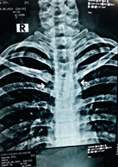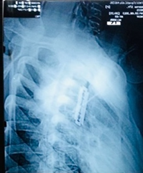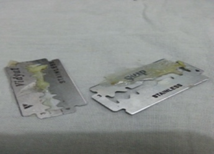Archive : Article / Volume 1, Issue 1
- Case Report | DOI:
- https://doi.org/10.58489/2837-3367/001
Razor Blade Foreign Body in Esophagus - A Case Report
- Principal and Head of the Department of ENT & Head-Neck Surgery Khulna Medical College, Khulna.
- Assistant Professor, Department of ENT & Head-Neck Surgery Khulna City Medical College, Khulna.
- Assistant Professor, Department of Anesthesiology Sheikh Shahid Abu Naser Specialized Hospital, Khulna.
- Resident, Department of ENT & Head Neck surgery Khulna Medical College & Hospital
- MPH student, Tata Institute of Social Science, Mumbai, India.
Sudhangshu Kumar Ballav
Sudhangshu. K. B, Saikat. B, Kazi. N, Ashim. S, Susmita. B., (2022). Razor Blade Foreign Body in Esophagus - A Case Report. Journal of ENT and Healthcare. 1(1). DOI: 10.58489/2837-3367/001
© 2022 Sudhangshu. K. B, this is an open access article distributed under the Creative Commons Attribution License, which permits unrestricted use, distribution, and reproduction in any medium, provided the original work is properly cited.
- Received Date: 31-07-2022
- Accepted Date: 16-08-2022
- Published Date: 20-09-2022
Razor blade, foreign body, esophagus, esophagoscopy.
Abstract
We are presenting a case of impacted razor blade in esophagus of a 17 year's teenage girl. Sharp cutting edge of razor blade may impose a challenge to remove the foreign body. We are sharing our experience of successful removal of razor blade from mid esophagus without any complications.
Introduction
Impaction of foreign body in an aerodigestive tract is quite common in ENT practice. It requires emergency removal. Sometimes impaction of foreign body causing esophageal perforation may be life threatening. Different kinds of foreign bodies may get impacted accidentally in aerodigestive tract. The deliberate ingestion and impaction of sharp razor blade had been a very rare instance. It may happen in case of psychiatric, intoxicated patients and in prisoners to gain hospital stay [1,2].
In this article we report a case of deliberate ingestion and impaction of two razor blades in mid esophagus of a teenage girl. It demanded emergency removal to avoid complications of esophageal perforation and its consequences. Razor blade is one of the common household commodities in rural Bangladesh. In case of razor blade impaction, expertise and urgent removal is mandatory to avoid severe morbidity or mortality [3]. The incidence of deliberate ingestion of sharp foreign bodies like razor blade is extremely rare. Hence, we do report our experience.
Abbreviations
"ENT= Ear Nose Throat", " mm= millimeter", "cm=centimeter", Fb="Foreign body".
Case report
A 17 year's teenage girl was admitted into ENT ward of Khulna Medical College Hospital, Khulna, Bangladesh with history of deliberate ingestion of two razor blades. The girl had a quarrel with her mother and out of emotion she deliberately swallowed razor blades. The patient was admitted into ENT ward within two hours of the incident. We had recorded detailed history and revealed no underlying psychiatric illness or any signs of complication. The patient complained only of retrosternal discomfort on swallowing.
We had screened the patient by handheld metal detector and heard positive signals in chest. There were no clinical signs of pneumothorax or pneumomediastinum. Radiography of chest was done in both anteroposterior and lateral views. It showed radio opaque shadow of razor blade (Fig-1, Fig-2) at T4 T5 vertebral level. We had planned for rigid esophagoscopy under general anesthesia. Available razor blade is 21mm in breadth and 41 mm in length. The diameter of adult esophagus is about 30 mm. We had used appropriate large size rigid Negus esophagoscope so that the razor blade could be negotiated into the lumen of the esophagoscope. On rigid esophagoscopy we had visualized the foreign body at 25 cm from the upper incisor teeth. We had removed the foreign body without difficulties. In this case the impacted foreign body was two razor blades wrapped in a piece of paper. We gave a second look up to lower end of esophagus and found no stricture, no second foreign body or any injury to esophageal wall. The patient was discharged on the second postoperative day with advice of soft diet and psychiatric consultation. We followed the patient after 7 days and found no complications.



Discussion
The incidence of foreign body impaction in aerodigestive tract had been in the society since ancient time. The patient with impacted Fb in upper gastrointestinal tract comprised most of emergencies in the ENT Department of any Hospital. The incidence of deliberate ingestion of sharp foreign bodies like razor blade is extremely rare. Intentional ingestion of unusual Fb may happen in psychiatric, intoxicated patients or in prisoners to gain benefit of hospital stay [1, 2]. We found few case reports of razor blade ingestion in the literatures where the victims were prisoner, alcoholic and psychiatric patients [4].
In case of razor blade ingestion expertise and prompt removal is mandatory as complications can cause severe morbidity or mortality. We detected the presence of metallic object inside the chest by handheld metal detector as was done by other researchers [5,6]. We found the use of metal detector judicious to screen the metallic foreign boy in aerodigestive tract.
The commercially available razor blades are wrapped by two pieces of paper. We found both the two blades new and wrapped by one piece of inner wrap. The patient had been thinking of injury, pain, and other consequences of sharp razor blade ingestion and for that she kept the blades inside a wrap as revealed on detail history in our case.
Most of the ingested foreign bodies passed out spontaneously without any complication while a few cases required endoscopic or surgical removal. About one third of ingested foreign bodies get impacted in the esophagus [7,8]. Most of the foreign bodies got impacted just at cricopharynx. The cricopharyngeal sphincter is strong enough to hold most of ingested foreign bodies. Other sites of impaction are the natural constrictions of the esophagus. We found the Fb in our case at the level of second natural constriction at 25 cm from upper incisor teeth. Most of the ingested smooth foreign body which had passed beyond esophagus usually passed out on its own way.
In our case we had used larger size rigid Negus esophagoscope to negotiate the razor blade inside the lumen of the scope. It was an easy task. In one case report the surgeon had broken the razor blade on their own technique to negotiate two halves into the lumen of the scope [8]. The sharp foreign body in the esophagus can cause esophageal perforation leading to life threatening complications [8]. So, quick diagnosis and urgent removal is mandatory.
Conclusion
The case report described is a relatively rare incidence of razor blade impaction in the esophagus. Conservative management for spontaneous passing out is not considered justified in case of razor blade or any sharp foreign body impaction anywhere in gastrointestinal tract. The emergency removal should be decided and done meticulously. The method of removal depends upon the expertise, type and location of the foreign body, and presence or absence of any complication at presentation. The victim of any unusual foreign body ingestion needs psychiatric evaluation.
Conflicts of interest
none
Sponsor
none
The approval of institutional ethical committee was obtained for this study.
Written consent from patient's guardian had been taken for publication.
References
- McCanse DE, Kurchin A, Hinshaw JR. (1981), gastrointestinal foreign bodies. Am J Surg; 142:335 -7. doi:10.1016/0002- 9610(81)90342-1
- Blaho KE, Merigian KS, Winbery SL, Park LJ, Cockrel M. (1998), Foreign body ingestions in the Emergency department:Case reports and review of treatment. J Emerg Med; 16:2 -6.doi: 10.1016/s0736-4679(97)00229-1.
- Pointer BA, Hunter JJ, Coverdale JH, Kempinsky CA. (2011), Hard to swallow: a systemic review of deliberate foreign body ingestion. Gen Hosp Psychiatry;33: 518 - 24.doi:10.10/ j.genhosppsych. 2011.06.011.
- Butterworth JR, Wright K, Boulton RA, et al. (2004), Management of swallowed razor blades- retrieve or wait, and see? Gut; 53:477
- Hamza HB, James V, Manickam S, Ganapathy S. (2018),Handheld Metal detector for Metallic Foreign body Ingestion in Pediatric Emergency. Indian J Pediatr.2018 Aug; 85(8):618-624. doi: 10.1007s12098-017-2552-5. Epub 2018 Jan 4. PMID: 29299756
- Nation J, Jang W. Int JPediatrOtolaryngol.(2017), Jan;92: 1-6.doi: 10.1016/j.ijporl.2016.10.035. Epub 2016 Nov1.PMID:28012507.
- Weissberg D, Rafaely Y. (2007), Foreign in the esophagus. The Annals of Thoracic Surgery, Vol.84, no.6, pp.1854-1857.
- Shelly KC, Gopalkrishnan S, Gopinath. An Unusual Sharp foreign body in The Esophagus And its Removal. http://doi.org/10.1016/S0194-59980300161-X9.
- Suraj S, Ranjan S, Suraj B, Sanjeev K, Bibek M S, Aakriti S. (2022), Esophageal Perforation following Accidental Ingestion of a Razor Blade, Case reports in Surgery, vol.2022, Article ID 1974147, 4 pages. http://doi.org/10.1155/2022/1974147


